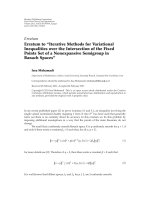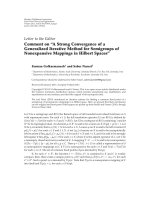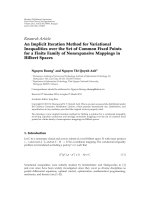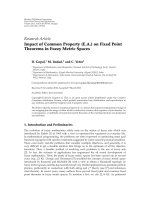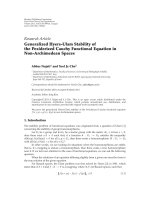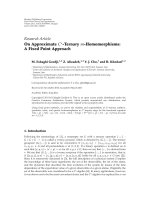Global positioning system theory and applications; volume II
Bạn đang xem bản rút gọn của tài liệu. Xem và tải ngay bản đầy đủ của tài liệu tại đây (10.6 MB, 336 trang )
Global Positioning System:
Theory and Applications
Volume U
Edited by
Bradford W. Parkinson
Stanford University, Stanford, California
James J. Spilker Jr.
Stanford Telecom, Sunnyvale, California
Associated Editors:
Penina Axelrad
University of Colorado, Boulder, Colorado
Per Enge
Stanford University, Stanford, California
Volume 164
PROGRESS IN
ASTRONAUTICS AND AERONAUTICS
Paul Zarchan, Editor-in-Chief
Charles Stark Draper Laboratory, Inc.
Cambridge, Massachusetts
Published by the
American Institute of Aeronautics and Astronautics, Inc.
370 L'Enfant Promenade, SW, Washington, DC 20024-2518
Progress in Astronautics and Aeronautics
Editor-in-Chief
Paul Zarchan
Charles Stark Draper Laboratory, Inc.
Editorial Board
John J. Bertin
U.S. Air Force Academy
Leroy S. Fletcher
Texas A&M University
Richard G. Bradley
Lockheed Martin Fort Worth Company
Allen E. Fuhs
Carmel, CD.lifornia
William Brandon
MITRE Corporation
Ira D. Jacobsen
Embry-Riddle Aeronautical University
Clarence B. Cohen
Redondo Beach, California
John L. Junkins
Texas A&M University
Luigi De Luca
Politechnico di Milano, Italy
Pradip M. Sagdeo
University of Michigan
Martin Summerfield
Lawrenceville, New Jersey
Dedication
To Anna Marie, Elaine, Virginia, and Tim
Preface
Overview and Purpose of These Volumes
Of all the military developments fostered by the recent cold war, the Global
Positioning System (GPS) may prove to have the greatest positive impact on
everyday life. One can imagine a 21st century world covered by an augmented
GPS and laced with mobile digital communications in which aircraft and other
vehicles travel through "virtual tunnels," imaginary tracks through space which
are continuously optimized for weather, traffic, and other conditions. Robotic
vehicles perform all sorts of construction, transportation, mining, and earth moving functions working day and night with no need for rest. Low-cost personal
navigators are as commonplace as hand calculators, and every cellular telephone
and personnel communicator includes a GPS navigator. These are some of the
potential positive impacts of GPS for the future. Our purpose in creating this
book is to increase that positive impact. That is, to accelerate the understanding
of the GPS system and encourage new and innovative applications.
The intended readers and users of the volumes include all those who seek
knowledge of GPS techniques, capabilities, and limitations:
• Students attending formal or informal courses
• Practicing GPS engineers
• Applications engineers
• Managers. who wish to improve their understanding of the system
Our somewhat immodest hope is that this book will become a standard reference
for the understanding of the GPS system.
Each chapter is authored by an individual or group of individuals who are
recognized as world-class authorities in their area of GPS. Use of many authors
has led to some overlap in the subject matter which we believe is positive. This
variety of viewpoints can promote understanding and contributes to our overall
purpose. Books written by several authors also must contend with variations in
notation. The editors of the volume have developed common notations for the
important subjects of GPS theory and analysis, and attempted to extend this,
where possible, to other chapters. Where there are minor inconsistencies we ask
for your understanding.
Organization of the Volumes
The two volumes are intended to be complementary. Volume I concentrates
on fundamentals and Volume II on applications. Volume I is divided into two
parts: the first deals with the operation and theory of basic GPS, the second
section with GPS performance and errors. In Part I (GPS Fundamentals), a
summary of GPS history leads to later chapters which promote an initial underxxxi
standing of the three GPS segments: User, Satellite, and Control. Even the best
of systems has its limitations, and GPS is no exception. Part II, GPS Performance
and Error Effects, is introduced with an overview of the errors, followed by
chapters devoted to each of the individual error sources.
Volume II concentrates on two aspects: augmentations to GPS and detailed
descriptions of applications. It consists of Parts III to VI:
• III.
• IV.
• V.
• VI.
Differential GPS and Integrity Monitoring
Integrated Navigation Systems
GPS Navigation Applications
Special Applications
Parts III and IV expand on GPS with explanations of supplements and augmentations to the system. The supplements enhance accuracy, availability, or integrity.
Of special interest is differential GPS which has proven it can provide sub-meter
(even centimeter) level accuracies in a dynamic environment. The last two sections
(V and VI) are detailed descriptions of the major applications in current use. In
the rapidly expanding world of GPS, new uses are being found all of the time.
We sincerely hope that these volumes will accelerate such new discoveries.
Acknowledgments
Obviously this book is a group undertaking with many, many individuals
deserving of our sincere thanks. In addition to the individual authors, we would
especially like to thank Ms. Lee Gamma, Mr. Sam Pullen, and Ms. Denise Nunes.
In addition, we would like to thank Mr. Gaylord Green, Dr. Nick Talbot, Dr.
Gary Lennon, Ms. Penny Sorensen, Mr. Konstantin Gromov, Dr. Todd Walter,
and Mr. Y. C. Chao.
Special Acknowledgment
We would like to give special acknowledgment to the members of the original
GPS Joint Program Office, their supporting contractors and the original set of
engineers and scientists at the Aerospace Corporation and at the Naval Research
Laboratory. Without their tenacity, energy, and foresight GPS would not be.
B. W. Parkinson
J. J. Spilker Jr.
P. Axelrad
P. Enge
Part III. Differential GPS and Integrity Monitoring
Chapter 1
Differential GPS
Bradford W. Parkinson* and Per K. Enget
Stanford University, Stanford, California 94305
I. Introduction
D
IFFERENTIAL GPS (DGPS) is a technique that significantly improves
both the accuracy and the integrity of the Global Positioning System. The
most common version of DGPS is diagrammed in Fig. 1. As shown, DGPS requires high-quality GPS "reference receivers" at known, surveyed locations. The
reference station estimates the slowly varying error components of each satellite range measurement and forms a correction for each GPS satellite in view.
This correction is broadcast to all DGPS users on a convenient communications
link. Typical ranges for a local area differential GPS (LADGPS) station are up
to 150 km. Within this operating range, the differential correction greatly improves accuracy for all users, regardless of whether selective availability (SA)
is activated or is not (see Chapter 11, the companion volume, on error analysis). This improvement arises because the largest GPS errors vary slowly with
time and are strongly correlated over distance. Differential DGPS also significantly improves the "integrity," or truthfulness, of GPS for all classes of users,
because it reduces the probability that a GPS user would suffer from an unacceptable position error attributable to an undetected system fault. (Integrity is the
probability that the displayed position is within the specified or expected error
boundaries.)
A.
Standard Positioning Service Users
The most dramatic DGPS improvement is found for the Standard Positioning
Service (SPS) when SA is activated. Although an SPS receiver itself is capable
of range measurement precision of approximately 0.5 m, the normal ranging
errors include slowly varying biases attributable to all six of the error classes
Copyright © 1995 by the authors. Published by the American Institute
Astronautics, Inc., with permission. Released to AIAA to publish in all forms.
of Aeronautics
'Professor of Aeronautics and Astronautics
Director of the GPS Program.
tprofessor of Aeronautics and Astronautics.
Physics Laboratory.
and of the Hansen Experimental
3
and
described in Chapter 11 of the companion volume. These are dominated by SA,
with one sigma ranging errors typically measured to be about 21 m. Without
differential corrections, these SA-dominated biases limit the horizontal positioning accuracy of the SPS to 100 m (approximate 95 percentile level). With differential corrections, the SPS navigation accuracy can be improved to better than
1 m (1 (1), provided that the correction age is less than 10 s, and the user is
within 50 km of the reference station. As the corrections age, or the geographic
separation from the reference station increases, the accuracy of DGPS degrades.
This degradation with range is graceful; thus LADGPS provides adequate accuracy for some applications at ranges of up to 1000 km.
B. Precise Positioning Service Users
As mentioned, DGPS also improves the performance of the Precise Positioning
Service (PPS). Without differential corrections, the PPS is significantly more
accurate than the SPS, because PPS users do not suffer from SA. In addition,
PPS receivers can use measurements at both GPS frequencies to reduce the
effect of ionospheric delays. Nonetheless, differential corrections can still provide
significant improvements to the PPS accuracy, which is nominally 15 meters
SEP (spherical error probable, which is the radius of a sphere that is expected
to contain 50% of the errors). Expected accuracies with DGPS are about the
same as SPS: they range from I to 5 m, depending upon the system design.
C.
1.
Local Area Differential GPS
Most DGPS systems use a single reference station to develop a scalar correction to the code-phase* measurement for each satellite. This approach is shown
in Fig. 1. If the correction is delivered within 10 s, and the user is within 1000
km, the user accuracy should be between 1 and 10 m. This capability (shown in
Fig. 3) is detailed further in Sec. II of this chapter. An additional technique uses
inexpensive, ground-based transmitters that broadcast a GPS signal at the L, or
~ frequency. These are called pseudosatellites or pseudolites (PL) and act as an
additional ranging source as well as a datalink. Pseudolites provide significant
improvements in geometri and accuracy; one technique is described under test
results and discussed in a later chapter on precision landing.
2.
Wide Area Differential GPS
As shown in Fig. 2, networks of reference stations can be used to form a
vector correction for each satellite. This vector consists of individual corrections
for the satellite clock, three components of satellite positioning error (or ephemeris), and parameters of an ionospheric delay model. The validity of this correction
Major Categories of Differential GPS
There are many DGPS techniques and applications.'·2
are broadly characterized in the following subsections.
The major techniques
*The modem technique for receiver code-phase measurements is to use "carrier aiding," which
filters the noisy code-phase measurements with the smoother carrier measurements. This is not to
be confused with pure carrier-tracking techniques described further later.
DIFFERENTIAL GPS
7
and shorter time constants must be used with some degradation of accuracy.
These static and kinematic capabilities are included in Fig. 3. Several carrierphase techniques for aircraft precision landing have also been demonstrated.
Carrier-phase DGPS is introduced in Sec. IV of this chapter and is further
described in Chapters 4. 15. 18. and 19 of this volume.
4.
Organization of the Chapter
This chapter introduces DGPS, and many of the remaining chapters apply or
further develop this important technique. Section I of this chapter describes the
measurements of a code-phase differential system. In Sec. III the error analysis
for a LADGPS is developed. Accuracy degradation for "aged" corrections and
for user displacements from the reference station are quantified. Section IV
introduces CDGPS by describing GPS phase interferometry for attitude determination as well as static and kinematic survey. It also introduces techniques for
resolving the A. or wavelength ambiguity. which must be determined to realize
centimeter-level accuracies. Section V describes standardized data formats for
the transmission of local area differential corrections. and Sec. VI provides an
overview of DGPS broadcast systems. Section VII provides a small sample of
the huge number of DGPS field results reported in the literature.
II.
still decreases with increased latency* or age of the correction. However, compared to a scalar correction. a vector correction is valid over much greater
geographical areas. This concept is called wide area DGPS. or WADGPS.4 Such
networks will be used for continental or even world-hemisphere coverage. because
they require many fewer reference stations than a collection of independent
systems with one reference station each. Moreover. they require less communication capacity than the equivalent network of LADGPS systems. Wide area GPS
is a subject unto itself. and it is described in detail in Chapters 3 and 4 of
this volume.
3.
Carrier-Phase Differential GPS
Users with very stringent accuracy requirements may be able to use a technique
called carrier-phase DGPS or CDGPS. These users measure the phase of the
GPS carrier relative to the carrier phase at a reference site; thus achieving range
measurement precisions that are a few percent of the carrier wavelength (typically
about one centimeter). These GPS phase comparisons are used for vehicle attitude
determination and also in survey applications, where the antennas are separated
by tens of kilometers. If the antennas are fixed. then the survey is called static,
and millimeter accuracies are possible. because long averaging times can be used
to combat random noise. If the antennas are moving. then the survey is kinematic,
*Latency is the total time from the reference station measurement of error to the actual application
in the user receiver. It includes the calculation time and any communications delay.
Code-Phase DitTerential GPS
It is useful to summarize the expected user errors in a form that allows analysis
of differential system accuracy. Errors can be categorized as either correlated
between receivers or uncorrelated. Only the correlated errors can be corrected
with DGPS. Even the nominally correlated errors lose that correlation if they
are significantly delayed in application (temporally decorrelaied) or are applied
to a receiver significantly separated from the reference station (geographically
decorrelated). This section provides estimates of these decorrelation factors.
A. User Errors Without DitTerential GPS
This section draws heavily on the development of Chapter 11. the companion
volume. which should be used as a reference. A code-tracking receiver actually
measures the raw difference between the user's biased clock and the transmitted
time of the start of the satellite code phase (which is part of the satellite message).
This quantity is called raw pseudo range p. With the speed of light c used to
convert time to distance. this is expressed as follows:
p
=
c·(tAu
-
tTs)
(1)
where tAu = Arrival time measured by the user. s; tT, = uncorrected value of
satellite Transmission time. s; and u,s represents the user and the sth satellite.
This is measured (or raw) pseudorange. which equals the true range D from the
user u to satellite s plus an unknown offset between the user clock b" and the
satellite clock B." Additional time delays are caused by the ionosphere I and
the troposphere T, as well as noise. multipath. and/or interchannel errors in the
12
DIFFERENTIAL GPS
B. W. PARKINSON AND P. K. ENGE
• Type 2: Decorrelation with Time. The tenn SPR' 6.t is the error attributable to the time rate of change of the corrections (decorrelation with time).
This effect is frequently called latency. To cope with time decorrelations,
most DGPS systems broadcast the measured time rate of change of corrections as part of the communicated message. This first-order correction usually achieves an accuracy of about 0.5 m for a 10 s delay. Higher-order
derivatives can be transmitted, but their estimates are noisy, and the prediction process is deliberately made difficult by the high-frequency changes
induced by SA.
13
because the autocorrelation of the CIA-code is nearly zero for delays greater
than 11/2 chips. However, if they are delayed by less than 1.5 f.Ls,their impact
depends upon their amplitude, the amount of delay, and the persistence of the
reflection. This persistence can be quantified as the correlation time.
Multipath errors, particularly in the reference station, should be the major
issue in selecting and siting reference antennas. Certain modem antennas have
substantial improvements in sidelobe suppression, which helps further eliminate
multipath before it can enter the receiver. Avoiding antenna sites close to reflective
materials can also help greatly. These considerations should be regarded as the
primary defense against multipath .
• Type 3: Uncorrelated Errors (not correctable with DGPS).
The last
term represents errors at the user that are not correlated with those measured
at the reference. This tenn can be viewed as the error for user and reference
if they were next to each other and there were no delay in application of
the corrections. Note that type 3 errors at both the user and reference station
contribute to the total DGPS user error.
These error types are not necessarily mutually exclusi ve. For example, ionospheric
errors are both type 1 and type 2, because they decorrelate with both time
and distance.
The subsequent sections analyze each of these error sources and present
estimates of residual errors after differential corrections. For each, the distance
and time decorrelation factors are also estimated. The preceding definitions of
decorrelation types are used in these discussions.
1.
Random Errors and Carrier Aiding
Code and carrier measurements both suffer from random observation noise,
which is denoted v for the code phase and <I> for the carrier. These random
variables model the impact of thennal noise, multiple access interference, and
multi path. In the absence of multipath, the standard deviation of the carrier noise
is 1 cm or less compared to over 1 m in the unaided code. Therefore, the carrierphase measurement is much more precise than the code measurement, but the
carrier measurement does suffer from the mentioned integer ambiguity N . X.
caused by the unknown number of carrier phase cycles between the user and
the satellite.
Carrier aiding is a technique that uses the precision of the carrier observations
to smooth the observed code-phase measurements. The following (fading memory) recursion is an example of a filter that is used:
A. Receiver Noise, Interference, and Multipath Errors for
DitTerential GPS
Receiver noise, interference, and multipath are grouped together because they
constitute the noise floor for DGPS. These errors are almost totally of type 3. They
have very short decorrelation distances; thus noise, interference, and multipath at
the reference station are not usually correlated with those effects at the mobile
receiver.
Special care must be taken with type 3 errors in the reference station. Any
effects in the reference correction will be directly added to the user error, because
they will be uncorrelated errors that are included in the broadcast correction.
Therefore, the elimination of these effects in the reference receiver is a primary
design goal. Fortunately, two techniques--carrier
aiding and narrow correlator
spacing--can minimize these effects. Their use has significantly reduced this
DGPS noise floor. Both techniques can be used with mobile receivers as well.
These are discussed in the following two sections.
Multipath arises when GPS signals travel over multiple paths from the satellite
to the receiver. Some of the signals are delayed relative to the "direct" signal,
because they have traveled paths that include a reflection. The reflecting object
might be a building, ship, aircraft, or truck, or it might be the surface of the sea
or of a runway. In general, the strongest reflections occur close to the receiver.
If these reflected signals are delayed by more than 1.5 f.Ls(about 500 m of
increased path length), they will be suppressed in the decorrelation process,
Pu,s(tk)
=
I
Pu,s(tk)
+ _L _~_l
(pu,s(tk-/)
+ <l>u,s(tk) -
<l>u,s(tk-I))
where
Pu,s(to)
=
Pu,s(to)
The first tenn of the recursion is the current code-phase measurement weighted
by IlL, where L is a large number, perhaps 100 or 200. The current codephase measurement receives a relatively low weighting because the carrier-phase
difference in the second tenn predicts the future value of the pseudorange with
very high accuracy. The forward prediction does not suffer from any integer
ambiguity because the carrier difference is used. Moreover, under most conditions, well-designed GPS phase-lock-loops (PLL) rarely suffer from cycle slips
that would degrade accuracy.
This carrier-aiding technique should not be confused with rate-aiding techniques, which use integrated Doppler measurements. Indeed, the carrier-phase
measurements maintain phase coherenc"y and do not suffer from accumulated
error growth caused by accumulated measurement noise. Nonetheless, the forward
prediction will eventually degrade because of code-carrier divergence (attributable to the ionosphere). In fact, the weighting constant L must be carefully chosen
to balance the very low noise of the carrier measurements with the accumulation
of code-carrier divergence. In the absence of significant multipath, carrier aiding
bounds the standard deviation of the pseudorange error to a few tenths of a meter.
DIFFERENTIAL GPS
15
As discussed by Refs. 5-7, multi path interference can be reduced further by
minimizing the time between early and late correlator samples. This is known
as narrow correlator spacing. A sample of the correlation function in the presence
of multi path is shown in Fig. 4. As shown, the multi path interference distorts
the shape of the correlation function, which is symmetric in the absence of
multi path. The advantage of narrow correlator spacing can be seen in the figure.
If the correlators are separated by 1.0 e, then the early and late samples will
settle at the location indicated, and the error caused by multipath can be quite
large. In contrast, if the correlator spacing is 0.1 Tc, then the correlator samples
will settle near the peak, and the error will generally be smaller than 1 m.
r
3.
Summary of Receiver Noise and Multipath Errors
Table 2 summarizes this class of ranging errors under the following
assumptions:
I) The user has a state-of-the-art, multichannel receiver with a modern digital
signal processor.
2) The reference station has taken great care to reduce multipath susceptibility,
as described in the preceding subsections.
3) The magnitude of the random error in the reference station is also found
in the user's receiver (but is uncorrelated) and multiplies this statistic by the
square root of 2.
If Lz. frequency measurements are used to track ionospheric delays, the time
constant of the filter can be much greater, thus better precision can be achieved.
On a moving vehicle, the multi path correlation time may be very small (because
the differential path length is changing rapidly), and carrier aiding may be quite
effective in averaging any disturbances. In fact, antenna designs that intentionally
randomize the phase difference between the direct and delayed signals are being
considered for moving platforms. At fixed sites, the correlation time tends to be
significantly longer; thus carrier aiding is not as effective. Of course, the antenna
can be more carefully located and designed to have very low gain at low or
negative elevation angles in order to combat multi path at a fixed location.
2.
Multipath and Narrow Correlator Spacing
In addition to antenna selection and siting, there is a receiver-processing
technique that can be used to mitigate (somewhat) the effects of multi path.
16
B. W. PARKINSON AND P. K. ENGE
Because these errors are all type 3, there is no decorrelation because of latency
or separation, as indicated in the three right-hand columns in the table. (Later
tables follow this same format.)
B.
Satellite Clock Errors for DitTerential GPS
Satellite clock errors are differences in the true signal transmission time and
the transmission time implied by the navigation message. In the absence of SA,
these errors are small and change slowly. During periods when SA was not
activated, clock errors of about 1-2 m and correlation times of about 5 min have
been measured.
In the presence of SA, clock errors of 20-30 m are not unusual. Differential
corrections can be very effective against clock errors, because their validity
decreases only with time and not with distance. In other words, this error is
exclusively type 2. Because SA has relatively large, fairly random velocity and
acceleration magnitudes, it totally dominates the latency-induced error growth.
The DGPS positioning error, therefore, grows as the DGPS correction ages.
Most DGPS implementations are relatively simple and predict future values
of the pseudorange correction from the current values of the pseudorange and
its rate. In this case, the residual pseudorange error growth attributable to SA is
approximated as 1/2 at2, where a is the rms acceleration (a random variable) of
SA, and t is the age of the correction in seconds. Typically, SA has exhibited an
acceleration a error in range (1 CJ') of about 4 mm/( S)2. Consequently, if the latency
is 10 s, then the pseudorange error (1CJ') attributable to SA is expected to grow
to approximately 0.2 m.
Somewhat more accurate DGPS systems have used system identification techniques in real time to build more sophisticated models of SA. Three good examples
are the following: I) a second-order Gauss-Markov models; 2) an autoregressive
moving average (ARMA) model9; and 3) a technique using autoregressive (AR)
models and lattice filters. 10
All of these models are still limited by the deliberate uncertainties in the true,
presumably nonlinear SA model. However some improvement can be realized
by transmitting the particular estimator model's parameters to the users as well
as the measured current state of the SA offset. The user's receiver can then
reconstruct the current approximation to the SA model to make more sophisticated predictions.
Figure 5 shows the standard deviation of the DGPS range error as a function
of the age of the correction. The error for a user without differential corrections
is the horizontal line at about 34 m. * The curve marked "two state" is for a
differential user who employs the simple prediction based on the current value
of SA and its rate. Finally, the curve marked "optimal prediction" is for a
differential user who uses a more complete estimator model (such as referenced
above) for predicting future values of SA. It assumes that the estimator model
parameters have been "optimally" estimated by including the known statistics
of SA.
As shown in Fig. 5, DGPS can reduce the pseudorange error provided that
the correction is delivered promptly. Note that the initial growth of the error
*This value is larger than typical SA errors which are closer to 23 m (I cr).
(first 30 s) for both cases is parabolic: it grows as time squared. In fact, a delay
of 20 s will lead to an error standard deviation of about 3 m in pseudorange,
which corresponds to a (2 drms) positioning error of approximately 10 m.
The error for the optimal prediction never exceeds that for a user without
corrections. In contrast, two-state prediction will give larger errors than nondifferential processing if the rate term is used to predict too far into the future. However,
the error for the two-state prediction is very close to that for optimal prediction
for smaller correction ages. For example, the differential error grows to over 10
m if the correction age exceeds 50 s, but for ages less than 50 s, the two-state
prediction is almost as good as the optimal prediction.
Table 3 summarizes the statistics for DGPS satellite clock errors.
C. Satellite Ephemeris Errors for DitTerential GPS
As mentioned earlier, the navigation message contains errors. We have asserted
that errors in the satellite clock data can be corrected by DGPS. Furthermore,
these clock corrections are valid regardless of the distance between the monitor
and the user. In other words, there is no decorrelation with displacement between
reference and user. On the other hand, if the errors are in the satellite ephemeris
data, then the validity of the corrections will decrease as the distance between
the user and reference station increases.
In the appendix to this chapter, there is a detailed development of the scalar
errors in DGPS ranging corrections as a vector function of the vector errors in
apparently has not been used. This is because any errors in the ephemeris would
be slowly changing, and hence, strongly correlated over many minutes. Therefore,
corrections for these errors would be valid for extended periods, which defeats
the purpose of SA. It is assumed that the worst case, if SA were used, would
limit the ephemeris message error to 100 m.
2.
Maximum Errors
The maximum separation between a user and a reference station that can still
have common view of all possible satellites is determined by their minimum
elevation angles, or mask angles. Figure 7 shows a reference station and a user
with a central angle separation of 142 deg (2.48 radians). This is the maximum
common view separation, assuming the user and reference station both have
elevation mask angles of 5 deg. The .maximum errors caused by this extreme
separation have three components that correspond to the three components of
satellite ephemeris error before differential corrections. Even at this extreme
separation, only the component parallel to the baseline (the vector between
reference and user) is not completely canceled by scalar DGPS. This is emphasized
in Table 4.
Table 5 summarizes the residual errors attributable to satellite ephemeris after
DGPS corrections are applied.



